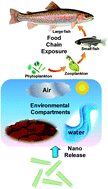Biological accumulation of engineered nanomaterials: a review of current knowledge
Abstract
Due to the widespread use of engineered nanomaterials (ENMs) in consumer and industrial products, concerns have been raised over their impacts once released into the ecosystems. While there has been a wealth of studies on the short-term acute toxic effects of ENMs over the past decade, work on the chronic endpoints, such as biological accumulation, has just begun to increase in last 2–3 years. Here, we comprehensively review over 65 papers on the biological accumulation of ENMs under a range of ecologically relevant exposure conditions in

- This article is part of the themed collection: Anthropogenic nanoparticles in the environment

 Please wait while we load your content...
Please wait while we load your content...